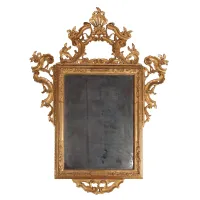A large French floor standing mirror - an antique from the late 19th century
Prestigious antique furniture and accessories.
SKU: NIMQUES-Sn4324
See other products from category Antique mirrors or from manufacturer Nimbus Antiques
Description
Large French standing floor mirror from the late 19th century, featuring an original mirror plate with excellent glazing and silvering, housed in a finely carved frame. The glass has a small crack in the upper right corner, but after such beautiful aging, we decided not to replace it. This can be done upon request.
Wonderful antique furniture and accessories can be an excellent idea for interior decoration. Today, there is an increasing number of enthusiasts of high-quality vintage items that possess a specific character and soul. This is a nod to history, craftsmanship, and the design of classic and timeless furniture. There are many different styles in antique furniture, each with its distinctive features.
Many styles characterize antique furniture, but we can highlight a few of the most important. Eclectic furniture dates back to the 19th century, during which the prevailing Biedermeier style was popular. Its early variations include neo-Gothic, Gothic, Rococo, Louis Philippe style, and finally the Victorian English style. Towards the end of the century, these styles evolved into pseudo-classicism, Renaissance, and Baroque styles.
Empire-style furniture and accessories originate from the period between the late 18th and early 19th centuries. Everything was influenced by Napoleon’s reign, which imposed a resemblance to Roman and Greek decorative motifs.
Neoclassical furniture reflects the Louis XVI style, which also strongly references ancient architecture. Notable and worth mentioning are antique products in Rococo and Louis XV styles. The next is Baroque, a term derived from the Portuguese 'barocco'—meaning an irregularly developed pearl. These were highly ornate pieces designed to radiate splendor and play a significant role in luxury. Unique materials were selectively used to emphasize the grandeur of these items.
Today, we can observe how much the Baroque style influenced modern classical furniture, which is designed with a strong resemblance to the historical period. An important style is also Renaissance, which flourished in the 15th and 16th centuries and left a significant mark on furniture craftsmanship. Renaissance furniture was quite heavy and massive, often using brown stains, moldings, sturdy bases, and relief decorations. These products were quite distinctive but also introduced new possibilities, such as the construction of credenzas and broadly speaking, chest-type furniture. Mythology and ancient times also inspired these designs, with supports and legs often taking animal forms.
Lion paws, eagle heads—these are common motifs in Renaissance style. Currently, many global brands recreate such furniture, drawing inspiration from Italian and French artisans. This reflects admiration and respect for the history of the most beautiful Renaissance antiques. It’s important to remember that furniture production was perceived differently in each country, giving each style a unique character. This is especially important when searching for elegant antique pieces suited for your interior.
The key aspect of elite antique furniture is originality. This is ultimately crucial for buyers, as many forgeries circulate on the market. Luxury Products provides documentation confirming the authenticity of each item in accordance with its description and photographs. We also have access to art appraisers, historians, and experts from around the world.
Attributes / Details
| SKU | NIMQUES-Sn4324 |
| Manufacturer | Nimbus Antiques |
| Model | Sn4324 |
| Size | W201cm W122cm D7cm 7cm crack |
| Wiek | XIX |
| Rok | 1880 |
| Stan | Po renowacji |
| Destiny | To home |
See catalog
Reviews
No reviews for this product.




















